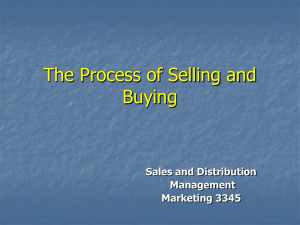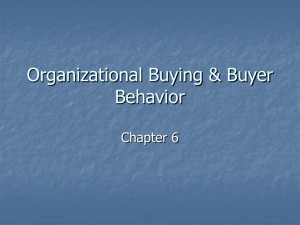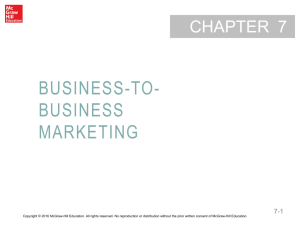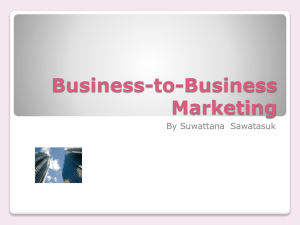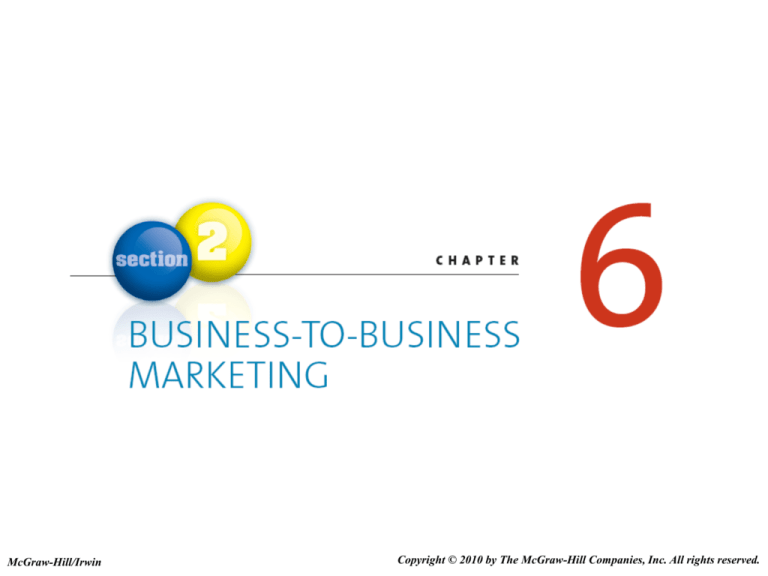
© McGraw-Hill Companies, Inc., McGraw-Hill/Irwin
McGraw-Hill/Irwin
Copyright © 2010 by The McGraw-Hill Companies, Inc. All rights reserved.
Learning Objectives
LEARNING OBJECTIVES
How do B2B firms segment their markets?
How does B2B buying differ from consumer
buying behavior?
What factors influence the B2B buying process?
How has the Internet changed B2B marketing?
6-2
B2B Marketing
Who is the end user?
6-3
B2B Markets
U.S. Census Website
6-4
Manufacturers or Producers
Buy raw materials,
components or parts
Manufacture their own
goods
Gear Expo News Clip
6-5
Resellers
Manufacturer
Reseller
Retailer
6-6
How is this B2B ad
similar to B2C ads?
6-7
In what kind of
publication might
this appear?
6-8
_________________ buy products from other
businesses but do not significantly alter the form
of the products they buy.
A.
Producers
B.
Consumers
C.
Resellers
D.
English auctioneers
E.
Gatekeepers
6-9
Chipwich Teaches Business
6-10
Institutions
Schools,
Museums and
Religious
Organizations
London Museum News Clip
6-11
Government
US Government spends
$2.1 trillion procuring
goods
State and local
governments also make
significant purchases
Firms specialize in
selling to government
6-12
Adding Value: Paris Runways
6-13
Check Yourself
1.
Identify the various types of B2B markets.
2.
What are NAICS codes and how are they
used?
6-14
B2B Buying Process
6-15
Compared to the B2C process, the information
search and alternative evaluation steps in the B2B
process are:
A.
central planned.
B.
subject to government regulation.
C.
more formal and structured.
D.
conducted before need recognition.
E.
all of the above.
6-16
Stage 1: Need Recognition
Can be generated
internally or externally
Sources for
recognizing new
needs:
Suppliers
Salespeople
Competitors
6-17
Stage 2: Product Specifications
Used by Suppliers to
develop proposals
Can be done
collaboratively with
suppliers
6-18
Stage 3: RFP Process
(Request for Proposal)
Federal Business Opportunities Website
6-19
Step 4: Proposal Analysis, Vendor
Negotiation and Selection
Often several vendors
are negotiating against
each other
Considerations other
than price play a role in
final selection
6-20
Step 5: Order Specification
Firm places the order
The exact details of the
purchase are specified
All terms are detailed
including payment
6-21
During the __________ stage of the buying process B2B
buyers invite alternative suppliers to bid on supplying
what is requested.
A.
information search
B.
need recognition
C.
RFP
D.
vendor analysis
E.
all of the above
6-22
Step 6: Vendor Analysis
6-23
Check Yourself
1.
Identify the stages in the B2B buying
process.
2.
How do you do a vendor analysis?
6-24
Factors Affecting the Buying Process
Organization
Culture
Buying
Situation
The Buying
Center
Buying
Process
6-25
The Buying Center
6-26
Which of the following is NOT one of the roles
typically played by one of the members of a
buying center?
A.
reseller
B.
initiator
C.
influencer
D.
decider
E.
gatekeeper
6-27
Wine Entrepreneur
6-28
Organizational Culture
6-29
Buying Situations
6-30
New Buy
•
Purchasing for the first
time
•
Likely to be quite
involved
•
The buying center will
probably use all six
steps in the buying
process
6-31
Modified Rebuy
Purchasing a similar
product but changing
specifications
Current vendors have
an advantage
6-32
Straight Rebuys
Buying additional units
or products that have
been previously
purchased
Most B2B purchases
fall into this category
6-33
In a ___________ B2B buying situation, the
buying decision is likely to be quite involved.
A.
new buy
B.
modified rebuy
C.
straight rebuy
D.
either a new buy or a modified rebuy
E.
all of the above
6-34
Power of the Internet
Putting Volkswagen Together
Realigned purchasing
Introduced iPAD
(internal purchasing
agent desk)
Cut time per order
from 60 to 20 minutes
Online connection to
suppliers
6-35
Role of the Internet in
Business-to-Business Marketing
Sales support
Virtual trade
shows
Product design
Private
exchange
Online
auctions
6-36
How is this ad B2B
and B2C?
6-37
Check Yourself
1.
What factors affect the B2B buying
process?
2.
What are the six different buying roles?
3.
What is the difference between new buy,
rebuy, and modified rebuy?
6-38
Glossary
Business-to-business (B2B) marketing refers to the
process of buying and selling goods or services to
be used in the production of other goods and
services, for consumption by the buying
organization, and/or for resale by wholesalers and
retailers.
Return to slide
6-39
Glossary
Buying center participants are people responsible
for the buying decisions.
Return to slide
6-40
Glossary
A private exchange occurs when a specific firm
(either buyer or seller) invites others to
participate in online information exchanges and
transactions.
Return to slide
6-41
Glossary
The request for proposals (RFP) is a process
through which buying organizations invite
alternative suppliers to bid on supplying their
required components.
Return to slide
6-42
Glossary
Resellers are marketing intermediaries that resell
manufactured products without significantly
altering their form.
Return to slide
6-43

